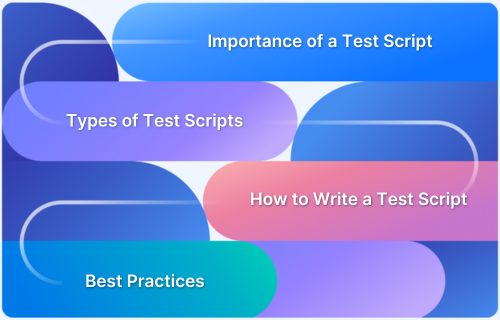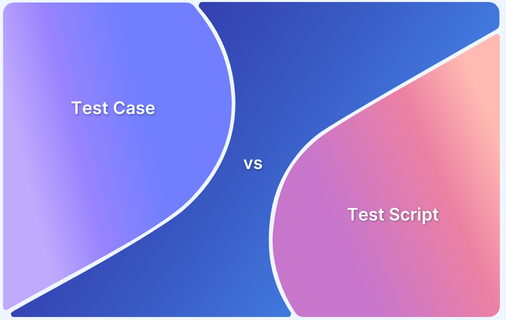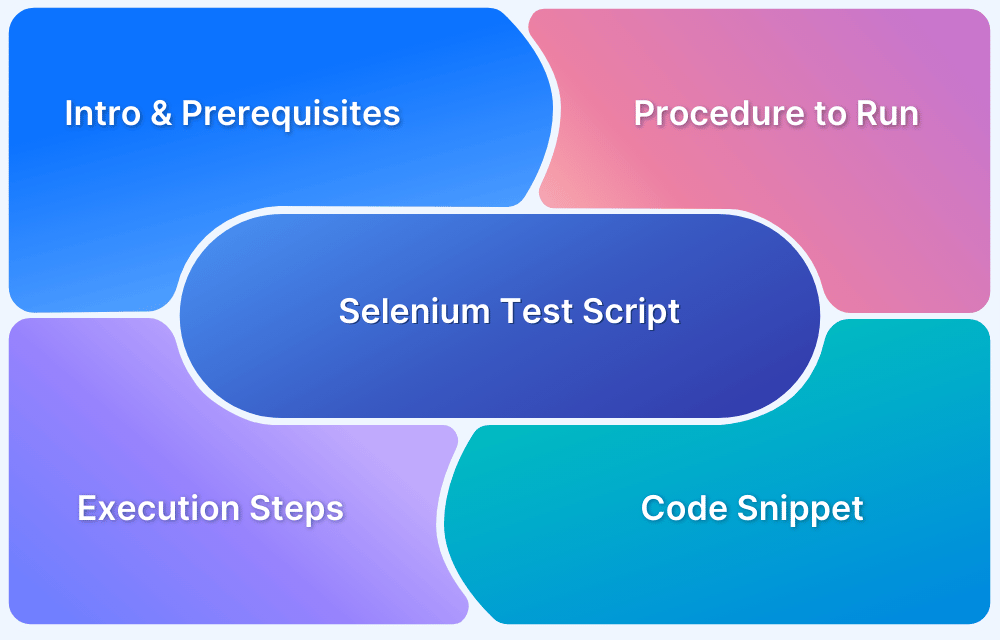As software evolves faster than ever, automated testing is crucial for maintaining quality. But here’s the catch: automation isn’t a “set it and forget it” process.
Test scripts need constant updates to keep up with changes in code, UI, and workflows. Without proper maintenance, tests can become unreliable, leading to false positives, negatives, or broken scripts.
In fact, over 50% of teams struggle with maintaining test scripts as apps evolve. That’s where test script maintenance comes in. It ensures your tests stay effective and scalable, so you can rely on them as your application grows.
Overview
Test script maintenance is the process of updating and managing automated test scripts to keep them functional and reliable as the application changes.
Why Automate Test Script Maintenance?
- Speed: Fast script updates
- Consistency: Fewer human errors
- Scalability: Supports large suites
- Cost-efficiency: Cuts resource use
- CI/CD support: Ensures reliable tests
Without proper maintenance, test suites can quickly become unreliable, producing false positives, false negatives, or even breaking altogether. Automated test script maintenance addresses this issue by streamlining updates, ensuring that tests remain effective and scalable over time.
What is Test Script Maintenance?
Test script maintenance refers to the process of updating, optimizing, and refactoring automated test scripts to ensure they continue working as the application under test evolves. As elements, APIs, or user flows change, scripts must be modified to reflect those updates.
The goal is to minimize test failures caused by outdated scripts while preserving coverage, reliability, and accuracy. Effective maintenance ensures test automation remains a long-term asset rather than a liability.
Read More: Test Case Vs Test Script
Why Automate Test Script Maintenance?
Manual test maintenance can be tedious, error-prone, and time-consuming. Automation helps address these challenges by:
- Speed: Automatically updating scripts to match evolving application elements.
- Consistency: Reducing human error and ensuring standardized updates.
- Scalability: Supporting large test suites across multiple platforms and environments.
- Cost-efficiency: Reducing the resource overhead needed for manual maintenance.
- Continuous testing support: Ensuring that tests remain reliable when integrated into fast-paced CI/CD pipelines.
Challenges in Maintaining Automated Test Scripts
Maintaining automated test scripts presents several difficulties:
- Frequent application changes: Agile teams often push new UI elements, API changes, or workflows, making scripts brittle.
- Dynamic elements: Locators for web or mobile apps may change, causing test failures.
- High maintenance costs: Large test suites require significant effort to keep updated.
- Tool and framework limitations: Not all automation tools offer intelligent handling of changes.
- False positives/negatives: Outdated scripts may incorrectly signal defects or stability.
Best Practices for Writing Maintainable Test Scripts
Strong maintenance starts with choices made at authoring time. The practices below focus on clarity, stability, and scale so scripts continue to pay dividends as the app evolves.
- Clear naming and structure: Use descriptive names for tests, pages, and helpers (e.g., Checkout_AddItem_ValidCoupon). Mirror product IA in folder/package layout (/pages, /components, /flows, /fixtures).
- Single-responsibility tests: Keep each test focused on one behavior. Multiple assertions are fine, but they should serve a single scenario to simplify failure triage.
- Stable, test-friendly locators: Prefer attributes made for automation (data-testid, data-e2e) over brittle CSS/XPath tied to layout. Avoid text-only selectors that change with localization.
- Encapsulation with Page Object or Screenplay patterns: Hide locator details and UI choreography behind methods like CartPage.applyCoupon(code) so refactors affect one file instead of every test.
- Reusable components and domain flows: Factor common steps (sign-in, seed data, navigate) into helpers or “flows” modules to minimize duplication and speed refactoring.
- Data-driven tests with fixtures: Externalize test data to JSON/YAML/CSV. Use factories or builders to compose realistic records and keep edge cases close to the test.
- Deterministic synchronization: Replace sleep() with explicit waits on conditions (element visible, network idle, request finished). Flakiness drops when waits reflect user-observable readiness.
- Idempotent setup and teardown: Create and clean data in predictable ways (API seeding, database transactions). Tests should run in any order and in parallel without clashing.
- Assertions that tell a story: Assert on user-visible outcomes and critical side effects, not incidental DOM details. Add custom messages to show “what was expected vs. what happened.”
- Configuration over code: Pull environment-specific values (base URL, creds, timeouts) from config files or env vars. Keep test logic constant across staging and production-like targets.
- Defensive retries at the edges: Use bounded, reasoned retries for known-flaky externals (third‑party widgets, network hiccups). Never mask genuine app bugs with blanket retries.
- Rich logging and artifacts: Capture console logs, network traces, screenshots, and videos on failure. Store them with a stable naming scheme to speed root-cause analysis.
- Linting, reviews, and style guides: Apply the same engineering standards to tests as to product code: linters, formatters, pre-commit hooks, and peer reviews.
- Traceability to requirements: Link tests to user stories or IDs in comments or metadata tags. This helps prioritize maintenance when features change.
- Smart tagging and test slicing: Tag tests by layer (@api, @ui), risk (@smoke, @regression), and component. Run the smallest meaningful set on each trigger to keep pipelines fast.
- Parallelization-safe by design: Avoid shared mutable state, random ports, and fixed usernames. Use unique test data and ephemeral resources so suites scale horizontally.
- Security and privacy for test data: Keep secrets in vaults, not in code. Use synthetic or anonymized datasets; scrub logs of sensitive values automatically.
- Accessibility-aware selectors: Prefer roles, labels, and ARIA attributes. This tends to be more stable and improves product accessibility in tandem.
- Contract tests for APIs; thin UI tests: Validate business rules at the API layer, where failures are faster to diagnose. Keep UI tests focused on end-to-end user journeys.
- Continuous flake triage: Quarantine known-flaky tests with a visible label, file a ticket with the owner, and budget time each sprint to reduce flake debt.
Minimal code illustrations
A test-friendly locator in the app markup:
<button data-testid="apply-coupon">Apply</button>
A small Page Object (Playwright, TypeScript) that hides selectors and waits:
export class CartPage {
constructor(private page: import('@playwright/test').Page) {}
private couponInput = this.page.getByTestId('coupon-input');
private applyBtn = this.page.getByTestId('apply-coupon');
private toast = this.page.getByRole('status');
async applyCoupon(code: string) {
await this.couponInput.fill(code);
await this.applyBtn.click();
await this.page.waitForResponse(r => r.url().includes('/api/coupons') && r.ok());
await expect(this.toast).toHaveText(/applied/i);
}
}Data-driven test using fixtures (Jest + Playwright):
import coupons from './fixtures/coupons.json';
test.each(coupons.valid)('applies coupon %s', async ({ page }, code) => {
const cart = new CartPage(page);
await cart.applyCoupon(code);
});Tooling tip: scale maintenance with the right infrastructure
Running maintainable scripts is easier when execution is reliable and representative. BrowserStack Test management provides real device and browser coverage in the cloud, CI/CD integrations, and artifacts (logs, screenshots, videos) that make failures actionable—useful for detecting locator breakage early and verifying fixes across environments without managing on-premise grids.
Implementing the Page Object Model (POM) in Script Maintenance
The Page Object Model is a design pattern that abstracts UI elements into reusable objects, separating test logic from implementation details.
Benefits of POM:
- Centralized element definitions make updates easier.
- Improves code readability and reduces duplication.
- Enhances test stability by isolating changes in UI locators.
For example, instead of hardcoding a login button’s locator in multiple tests, POM defines it in one place, ensuring updates are quick and consistent.
Utilizing Modular and Reusable Test Components for Test Script Maintenance
Breaking tests into modular, reusable components makes maintenance easier and reduces duplication. Below are the main areas where modularity adds value.
Core Types of Reusable Components
- Page objects and screen objects: Encapsulate UI locators and actions within a single class, so changes in element selectors only affect one place.
- Domain flows: Represent complete business processes like checkout or returns by combining multiple steps into a reusable flow.
- Test data builders and factories: Generate valid and edge-case test data dynamically, ensuring consistency and reducing redundancy.
- Utilities and service clients: Provide APIs or helpers for recurring tasks such as database seeding, feature flag toggling, or email polling.
- Assertions and matchers: Capture business rules in reusable custom assertions, improving readability and debugging.
Principles for Designing Modular Components
- Single responsibility: Keep each component focused on one function to minimize cascading failures.
- Stable, intent-revealing interfaces: Use descriptive method names like applyCoupon or proceedToPayment instead of low-level click actions.
- Thin UI, thick flows: Keep page objects minimal while pushing complex multi-step logic into higher-level flows.
- Dependency injection: Pass drivers and config explicitly instead of relying on hidden global state.
- Pure functions: Use immutable builders and helpers to reduce side effects and increase predictability.
Structuring for Scalability
- Predictable folder layout: Organize scripts into /pages, /flows, /data/builders, /utils, and /assertions for easier discovery.
- Centralized selectors: Keep locators only in page objects to avoid duplication and scattered changes.
- Versioned components: Introduce new versions when breaking changes are needed, while deprecating older ones gracefully.
- Documented contracts: Add comments and type hints to clarify usage, inputs, and outputs.
- Ownership and changelogs: Assign responsibility for shared modules and record changes to support cross-team collaboration.
Patterns and Anti-Patterns
- Parallelization-safe design: Ensure tests and flows avoid shared mutable state, making them safe for concurrent execution.
- Idempotent setup and teardown: Design helpers so that data setup and cleanup work reliably across environments.
- Anti-pattern – god objects: Avoid creating massive all-in-one page objects that are hard to maintain.
- Anti-pattern – hidden logic in fixtures: Prevent test data files from embedding side effects that obscure failures.
- Anti-pattern – brittle helper chains: Avoid helpers that directly mirror current UI layouts, as they break on small design tweaks.
Measuring Reuse and Maintenance Impact
- Duplication rate: Track repetitive sequences across tests and replace them with shared flows.
- Churn hotspots: Monitor frequently edited files to identify candidates for modularization.
- Mean time to fix: Measure the time it takes to update broken tests after app changes—shorter times reflect healthier modularization.
Running Modular Components at Scale
- BrowserStack integration: Execute modular flows on real devices and browsers in the cloud, ensuring selectors and flows are resilient across environments.
- Artifact capture: Use screenshots, logs, and videos from BrowserStack runs to quickly identify failing components.
Leveraging AI and Machine Learning for Test Maintenance
Modern automation frameworks increasingly incorporate AI/ML to reduce maintenance efforts.
Applications include:
- Self-healing locators: AI dynamically adjusts element locators when UI changes occur.
- Intelligent test suggestions: Machine learning recommends scripts to update based on app changes.
- Anomaly detection: Identifies flaky tests and reduces false results.
These features significantly cut down on manual intervention.
Integrating Automated Tests into CI/CD Pipelines for Test Maintenance
CI/CD pipelines ensure that tests run automatically after every code commit or build. Maintaining scripts in this setup ensures rapid feedback and stable releases.
Key considerations:
- Automate regression tests for every build.
- Prioritize fast-running smoke tests for early failure detection.
- Ensure integration with tools like Jenkins, GitHub Actions, or GitLab CI.
- Configure pipelines to flag outdated or failing scripts quickly.
To ensure seamless integration of automated tests into your CI/CD pipeline and maintain their effectiveness, expert guidance is crucial.
Get Expert QA Guidance Today
Schedule a call with BrowserStack QA specialists to discuss your testing challenges, automation strategies, and tool integrations. Gain actionable insights tailored to your projects and ensure faster, more reliable software delivery.
Version Control and Documentation Strategies for Automated Test Script Maintenance
Test scripts should follow the same version control practices as application code.
Strategies:
- Use Git or other version control systems for tracking changes.
- Maintain clear commit messages for script updates.
- Document test workflows, assumptions, and changes for team visibility.
- Tag stable releases of test suites alongside application versions.
Monitoring and Reporting for Test Health
Ongoing monitoring ensures the stability of test suites over time.
Effective monitoring practices:
- Track flaky tests and resolve root causes.
- Use dashboards for visibility into test execution trends.
- Automate reporting with logs, screenshots, and metrics for failed tests.
- Review test coverage regularly to identify gaps.
Training and Collaboration for Effective Test Script Maintenance
Even with automation, human expertise remains vital for successful test maintenance.
Key steps:
- Train teams on frameworks, best practices, and design patterns like POM.
- Foster collaboration between QA, development, and DevOps teams.
- Encourage knowledge-sharing sessions for script maintenance strategies.
- Define ownership of test suites to avoid neglected scripts.
Why use BrowserStack for Test Maintenance?
Maintaining test scripts across diverse environments can be overwhelming without the right infrastructure. BrowserStack Test Management simplifies this process by providing an integrated platform to manage, monitor, and optimize automated testing workflows.
Key advantages include:
- Real device coverage: Validate scripts on 3500+ real browsers and devices.
- Test management dashboard: Centralized visibility into script health, execution, and maintenance needs.
- Seamless CI/CD integration: Run tests directly from pipelines for continuous validation.
- Debugging support: Access logs, screenshots, and video recordings to fix failing scripts quickly.
- Scalability: Parallel execution ensures faster maintenance cycles for large test suites.
By using BrowserStack, teams reduce the complexity of maintaining automation while ensuring that tests reflect real-world performance.
Conclusion
Automated test script maintenance is essential for keeping automation effective as applications evolve. Without it, test suites quickly degrade, creating bottlenecks and unreliable results. By adopting design patterns like POM, modular test components, AI-driven maintenance, and strong version control, teams can minimize upkeep while maximizing test reliability.
With BrowserStack Test Management, organizations gain the ability to maintain, monitor, and execute test scripts at scale on real devices, ensuring long-term efficiency and reliability. This makes test automation not just sustainable but a core driver of quality in continuous delivery.







